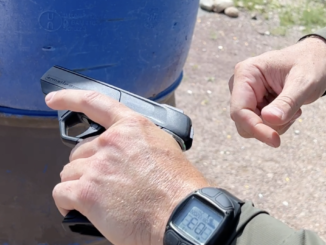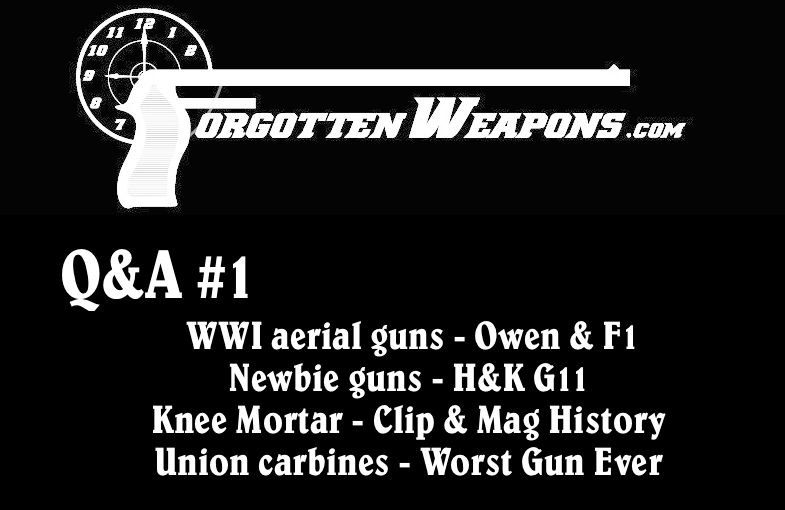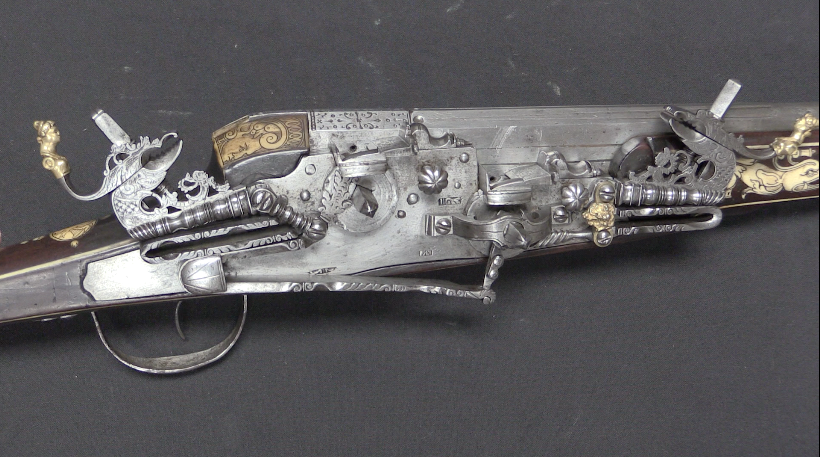Today I’m out at the range with three examples of Walther PPK pistols – one in .22 rimfire, one in .32 ACP, and one in .380 ACP. While the .22 is along for the comparison, I am mostly curious about how the .32 and .380 will compare to each other in practical shooting. The .32 will have less recoil, and holds 7 rounds in the magazine. The .380 fires a larger projectile, but produces more recoil and holds only 6 rounds.
I was a bit surprised to find that both are quite nice to shoot, the .380 especially – I had expected it to be a bit uncomfortable because of the small size of the PPK…
Thanks to Legacy Collectibles for the loan of these three Walthers!




Pocket guns in .32 were pretty much all the rage for European cops and gangsters alike during the Depression years. Those counted as “not powerful enough to be front-line military grade” but nasty enough that one would hate to be on the receiving end. Nobody pulls off a 1930’s bank heist in a suit of steel armor, after all. I could be wrong.
A 7.65mm/.32 can move mountains in the movies, especially James Bond movies. “…with a delivery like a brick through a plate glass window”…
Generally, the .32 ACP has slightly better penetration than the .380 at any given range. Neither one is of much use beyond 50 yards, but they were intended for targets at no more than 10 to 15 yards to begin with.
Within their effective range, the difference between the two wouldn’t pay the target’s burial expenses.
cheers
eon
In the books, Bond carried a .25 Beretta.
In the first few books. He later switches to the PPK though due to a problem with the Beretta 418.
This video is interesting and topical to the above.
https://www.youtube.com/watch?time_continue=13&v=g5BcvbSzCzI&feature=emb_logo
A thrown brick and a .32 ACP bullet carry about the same energy.
“Nobody pulls off a 1930’s bank heist in a suit of steel armor, after all. I could be wrong.”
At last report, Ned Kelly was still dead
Does anyone wonder that one of the best pistols of its time can comfortably shoot and hit the target?..
By the way, armor in those years was quite common among robbers and cops.
One of the serious shortcomings of the 9×17 Walther PPK was its relatively short service life due to the insufficient structural strength for this cartridge.
This also applies to modern (especially modern) replicas of this pistol.
“Armor” consisting of surplus “ballistic” nylon and garbage can lids? Very funny…
There was a lot of work with things like thick layers of silk and lightweight steel scale armor. A “bullet-proof” vest plays an important role in one of the Thin Man movies.
A well made silk padded vest was proof against 7,63 × 25 mm at point blank. Shooting any form of “bulet proof” vest with a C96 was the standard to beat.
Guys on the Walther forum shoot their 380s regularly for decades and I’ve never ever read any of them worry at all about this. I don’t buy it.
Previous comment was supposed to be a reply to the supposed short service life of 380s.
I’ve one of the newer .380 PPK/S models from Smith, as well as an older .22 TPH and Manurhin PP in .32 and they’re all very accurate. The TPH, like your .22 PPK is ammo sensitive, so much so that there’s recommended types in the manual, but once you dial that in, it’s a little tack driver.
I don’t shoot the PP as much, but that’s my time shortcoming, not the gun’s, and the PPK/S would be a great carry gun if it weren’t so heavy, which, if course, makes it more pleasant to shoot. Much more so than my old G42.
Apparently the newer guns have had troubles, but I’ve been very satisfied with mine and would recommend finding one to try. You can always sell it for what you paid with that 007 cache.
Yes, You are right, in our time, it costs a lot of nerves for dealers. There is a reputation and advertising, but no product.
“Mostly”, this usually works.
And for those who are “not very”, there is a lifetime warranty. 😉
I’d like to see a head-to-head shooting comparison with the PPK and the Mauser HSc both in .380. I like the functional features of the HSc like the slide closing on insertion of the magazine.
That is a beautiful gun!
Love the design and sleek lines of the classic Walters!
(And extra props for Ian going action movie hero-sorta on us!
Is it as powerful as a 9mm or .45? No, obviously. But in reality, it’s be perfectly adequate as a small, concealable self defense gun.
For real “bump trauma”, the winner(?)is the Hungarian FEG R61 in 9 x 18mm Makarov. A friend of mine referred to the one I had as the “Noisy Cricket”, and I think you can guess why.
My PA-63 in 9 x 18 was considerably more comfortable to shoot, but the R61 was every bit its equal in accuracy out to 50 yards. Either one shot about as well as my S&W Model 10 “Victory” 5″.38 S&W, and there’s nothing wrong with that.
cheers
eon
I would love to see a comparison of the Radom P64 in 9mm Makarov and a Walther PPK in .380. The two guns are similar in size, look similar as well, but the P64 is a different design.
I was thinking the same thing. A comparison with a Makarov would be great. My guess is the PPK might have an edge in accuracy with the Maks poor trigger. Also I saw 007 shoot down a helicopter with his PPK.
The simplest way to shoot down a helicopter? Hit the pilot.
A helo pilot has to maintain control of the aircraft every second. Disable him, it’s going down.
The helicopter most often used by the Bad Guys in 007 movies was the old Bell 47. There is no protection from any sort of small-arms fire in that aircraft, as the U.S. Army learned the hard way in Korea and the early years of Vietnam.
In both wars, the Army attempted to use armed OH-13s (the military designation) as proto-gunships, and found that even four .30 cal. Browning MGs mounted on the skids were no match for one guy on the ground with a rifle who knew what he was doing.
So no, “shooting down” a helicopter other than a designed-from-scratch anti-tank type with even a handgun isn’t as far-fetched as you think. There’s a reason Cobras and Apaches are armored to resist 20mm and 23mm cannon rounds, respectively.
And even then, the pilots and gunners don’t like to think about somebody on the ground with a rifle getting a shot at their canopies- and them personally in the cockpit.
cheers
eon
“Also I saw 007 shoot down a helicopter with his PPK.”
In which movie exactly? I remembered helicopter chase was in FROM RUSSIA WITH LOVE but rifle was shoot and helicopter itself was destroyed by grenade which one of bad-guys was about to throw, see: https://www.youtube.com/watch?v=4oD3vvgb3vk
The last, Spectre.
Eon, Four guns…no way.
“XM1/XM1E1
In service between 1960 and 1972, the XM1 consisted of two .30-caliber M37C machine guns mounted on the landing skids of either the OH-13 or OH-23 helicopter. These weapons were fixed forward, but flexible in elevation, with their ammunition (500 rounds per gun) stored externally. The XM1E1 was the product engineering design.[57] What would appear to have been a variant of the XM1 system was used by UTTHCO on their HU-1As (later UH-1A) for a short period.[58]M2 on the OH-13
M2
The M2 system was a variation on the XM1, replacing the .30-caliber M37C machine guns with 7.62×51mm NATO M60C machine guns. The mounts were similar to the XM1, also providing flexible elevation, with 650 rounds per gun stored externally.[3]”
https://en.wikipedia.org/wiki/U.S._helicopter_armament_subsystems#/media/File:Xm1m37c.gif
See “We Armed The Helicopter” By Col Jay D Venderpool, who was Armed Helicopter Project Officer at Ft Rucker, in Army Aviation Digest back issue (to be fair, Rucker was inspired by the French effort in Algeria)
I used a PP in 22LR back in the day. Walther had thinned the slide in front of the racking serrations compared with the center fire calibers. This was obviously to lighten the slide. Even so it was only reliable if fed high velocity ammo since it wouldn’t otherwise cycle enough to feed a new round. Exactly the same with the 22 TPH I had. I never had any problem with light hammer strike though so perhaps Ian had some substandard ammo there.
I really appreciate Forgotten Weapons, especially when Ian goes down to the range. It’s great to have objective comment from a knowledgeable individual who’s also happy to say “This is not what I was expecting”